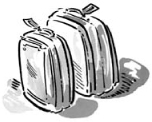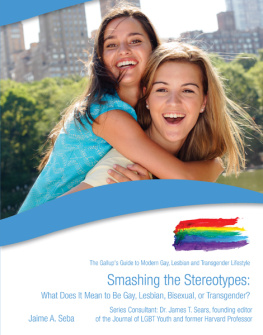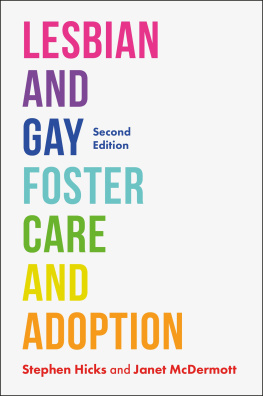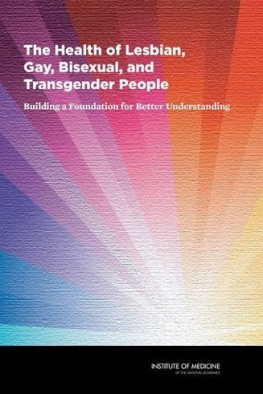STEVEN PETROWS
COMPLETE GAY & LESBIAN MANNERS
THE DEFINITIVE GUIDE TO LGBT LIFE

WITH SALLY CHEW
WORKMAN PUBLISHING NEW YORK
Copyright 2011 by Steven Petrow
Design copyright by Workman Publishing
All rights reserved. No portion of this book may be reproducedmechanically, electronically, or by any other means, including photocopyingwithout written permission of the publisher. Published simultaneously in Canada by Thomas Allen & Son Limited.
Library of Congress Cataloging-in-Publication Data is available.
eISBN 9780761165323
Illustrations by Paul Cox
Author photo by Bryan Regan
Stock photo p175 Galina Barskaya/Fotolia
All names appearing in this work are fictitious. Any resemblance to real persons, living or dead, is purely coincidental.
Workman books are available at special discounts when purchased in bulk for premiums and sales promotions as well as for fund-raising or educational use. Special editions or book excerpts also can be created to specification. For details, contact the Special Sales Director at the address below or send an e-mail to specialmarkets@workman.com.
WORKMAN PUBLISHING COMPANY, INC.
225 Varick Street
New York, NY 10014-4381
www.workman.com
For Jim
With love and gratitude
Support LGBT nonprofitsA percentage of all author royalties are donated to the fight for equal rights and protection for all including the excellent work of the Gay, Lesbian and Straight Education Network (GLSEN) and the National Center for Lesbian Rights (NCLR)
Contents
CHAPTER 1
COMING OUT
CHAPTER 2
FRIENDSHIP
CHAPTER 3
DATING
CHAPTER 4
SEX ETIQUETTE
CHAPTER 5
COMMITTED RELATIONSHIPS
CHAPTER 6
WEDDINGS & COMMITMENT CEREMONIES
CHAPTER 7
STARTING A FAMILY
CHAPTER 8
LGBT PARENTING
CHAPTER 9
THE ART OF CONNECTING
CHAPTER 10
SOCIAL OCCASIONS
CHAPTER 11
ON THE JOB
CHAPTER 12
OUT & ABOUT
CHAPTER 13
ILLNESS & GRIEVING
Introduction
E very time Ive mentioned over the past few years that I was writing a book on lesbian, gay, bisexual, and transgender (LGBT) manners, I got pretty much the same quizzical look. You know the one: the arched eyebrow, the piercing stare. Youre probably doing it right now. It took me a while to figure out what was going on, but then it dawned on me: The whole idea of LGBT manners is new, and somewhat baffling to most everyone. It turns out that behind that look are some very provocative and meaningful questions.

Let me start with perhaps the most personal question I get asked: Where does an imperfect fellow like me get off writing a book like this? Ive stumbled over introductions, asked to bring a boyfriend du jour to a formal wedding, and committed serious violations of the PDA rule (on the beach, in bars, even in the rafters of a Broadway theater). My worst transgression? I once outed a lesbian colleague who, while quite open with her friends about her sexual orientation, was not ready for me to tell our coworkers. Does all this mean that Im a hypocrite to be writing about manners? I dont think so. Just a realistand probably not very different from those of you who try to do the right thing but sometimes make gaffes or fall short.
Then there are the questions from those who find manners books to be pass or just irrelevant to their lives. How much does anybody really care where the fish fork goes or what the correct order is for a monogram on your shirt pocket or personal stationery? My answer: I dont lose sleep over such fussy details. This book takes a larger point of view: I argue that treating everyone with respect and decency makes for a better and fairer world, and that manners are among the best ways to make sure we start outand continueon the right foot.
That is what much of my work is about: Helping people live with greater confidence and self-esteem through simple principles of human kindness; demonstrating how much language matters; urging recognition of LGBT families and their new or invented traditions; and documenting the customs and practices of our commitment to and love for each other.
Its up to you whether forks and monograms enter into this picture. I do feel, however, that having a contemporary version of a few key old-school manners in mindor at least on hand for referencegives us the freedom to focus on more pressing matters.

Heres another question Ive been asked frequently: Are gay manners any different than straight ones? My answer: No, we dont set the table any differently than straight people. Nor do we treat houseguests in any special way. Values are values, whether youre LGBT or straight. But, yes, our weddings, our childrens coming-of-age ceremonies, and many of the other rites and rituals we participate in often have a decidedly different flavor. Consider these five contemporary LGBT manners predicaments:
- If a child has two mothers and a known sperm donor, what does he or she call them?
- If youre the victim of anti-gay bullying, how do you respond and stay safe?
- If youre going through a gender transition, what and when do you tell others?
- If youre HIV-positive, whens the right time to reveal your health statusand when is it not a good idea at all?
- If youre persona non grata to your lovers parents, how do you handle the holidays and other family get-togethers?
Unfortunately, you wont get much help on the particular manners quandaries of LGBT people and families from mainstream etiquette books. Were largely invisible there. Those authors dont advise a gay or lesbian person how to make a domestic-partner or a civil-union proposal. They dont explain the mechanics of planning a funeral or composing an obituary when a partners family doesnt recognize your status as next-of-kin. Even in their newest editions, theres not a word about bisexual or transgender people. Sadly what is written about gay people ishow can I phrase this in a mannerly way?homophobic. (That is, except for the very gay-friendly Judith Martin, aka Miss Manners.) Take, as an example, the editorial decision in The Amy Vanderbilt Complete Book of Etiquette to talk about the rise of gay families as a result of the breakdown of the traditional family.
In these pages, by contrast, LGBT people are front and center, out and proudwith our straight friends and families a little to stage right (but still respectfully in full view). The book deals with uniquely LGBT etiquette questions, but often in the context of more general ones. For instance, while seeking a job, theres the matter of deciding whether or not to be out on your rsum. Or when traveling, what to do if you have trouble checking in as a same-sex couple. The discussion on manners during the holidays and at other social occasions is full of advice on dealing with family members who might not accept your sexual orientation or gender identity, or who dont treat your partner (if you have one) the same as a straight siblings spouse.

Next page






![Chuck Stewart - Lesbian, Gay, Bisexual, and Transgender Americans at Risk [3 Volumes]: Problems and Solutions](/uploads/posts/book/129596/thumbs/chuck-stewart-lesbian-gay-bisexual-and.jpg)




